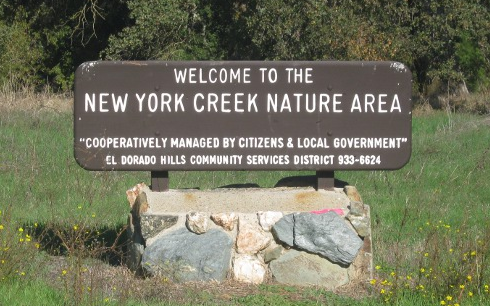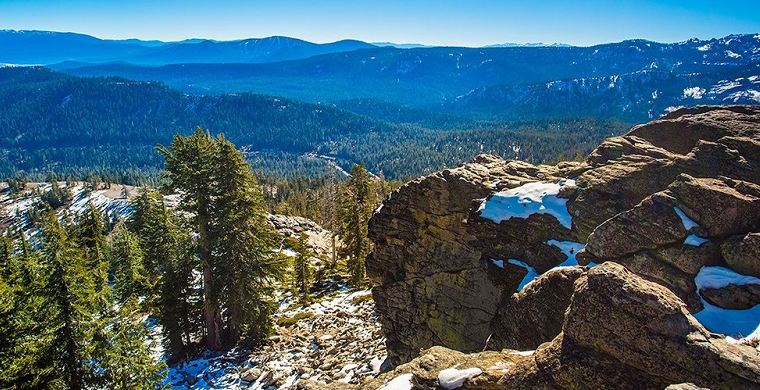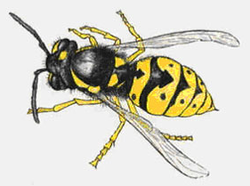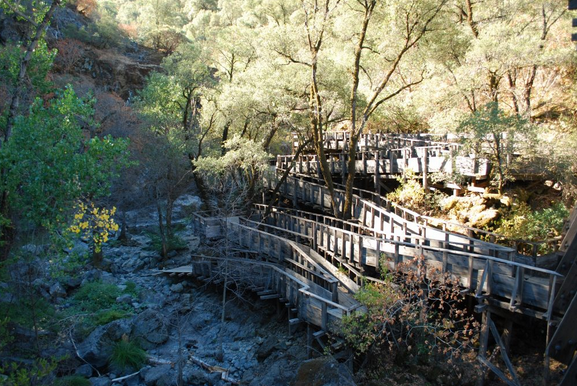To read the rest of the article by Julie Samrick n the Mountain Democrat newspaper CLICK HERE.
Earlier this year the CSD sent notices to 20 homeowners who live between Jackson Elementary and Falkirk Way that the district would be widening the trail to 8 feet to safely make it multi-use while retaining its wooded characteristics.
Although a “no bike” ordinance has been in effect since 1986, many cyclists use the trail, including recreational mountain bikers and children who use it as a safe route to travel off main roads. After the CSD sent out the notice, neighbors argued both for and against a multi-use trail. Those in favor said bicyclists and pedestrians had been peacefully coexisting on the trail while others said they thought the clean-up would encourage more bicycle use and threatened lawsuits if the CSD performed the work (some of which was recently done by a contractor).
Since then the CSD held a stakeholder process to get the community’s input, which included two public meetings, an internet survey (Flashvote), emails and handwritten letters, as well as comments received during public meetings.
On Thursday Loewen told the board that his recommended action is: 1. Support continuation of the New York Creek Trail Interpretive Signage Capital Project, excluding trail widening to accommodate multi-use and 2. Uphold and support the pedestrian-only status of New York Creek Trail from St. Andrews Drive to Brackenwood Place.
“While the subject matter expert hired to assist the district with the stakeholder process has made a recommendation for permitting bike use in the form of walking bikes from the paved commuter connector (under the PG&E/SMUD power lines) southward, such an accommodation would further distort an already difficult pedestrian-only rule,” Loewen wrote in the report ahead of the vote. “Further, the benefits portrayed by multi-use proponents for permitting bike use (e.g., safe route alternative; healthy recreation activity in a unique setting) would not be realized by this compromise to the pedestrian-only status. In the event that a compromise be considered in which actual riding of bikes is allowed, then the Falkirk trailhead is the most viable option in which such a compromise could be made.”
Director Billy Vandegrift made a motion to approve Loewen’s recommendation to keep the trail pedestrian only, but it failed for lack of a second.
Director Noelle Mattock then made a motion to approve the first portion of Loewen’s recommendation — to add interpretive signage on the trail. The signage would be educational for the public and would include a list of concepts including, but not limited to, the New York Creek Watershed, oak woodland ecosystem, wildlife, human impacts to creek, trail etiquette at each trailhead and cultural resources and history of indigenous people to the area, including Miwok-Nisenan inhabitants.
Mattock also made a motion to make the New York Creek Trail pedestrian only from Brackenwood to Falkirk Way, the one-mile stretch described as the most “pristine,” “with the densest vegetation” and the subject of debate.
The two motions were seconded by Director Allan Priest. It was opened to discussion and Directors Mattock, Allan Priest and Ben Paulsen voted for the compromise. Vandegrift voted against. Director Wayne Lowery was not at the meeting but Loewen said he would have abstained from voting due to a conflict of interest because his home backs to the portion of the trail in question.
The following day neither pro-bike nor pedestrian-only advocates said they were happy with the decision." Click on the article to read comments.
Today, the community is starting to respond with op-eds and letters to the Board, so far only from the pedestrian-only advocates...here is one written to Village Life:
"Noelle Mattock, Ben Paulsen and Allan Priest:
On Aug. 10 you voted to proceed with the El Dorado Hills Community Services District’s plans to allow a mountain bike trail in the southern half of New York Creek. This area was deeded to CSD 30 years ago after CSD publicly promised to preserve this area as a pedestrian-only nature preserve.
This year the CSD held a six-month stakeholder process on this issue only after overwhelming objection to its ill-conceived plan to force through a previously undisclosed multi-use alteration of the nature path. The stakeholder process confirmed majority support to keep this are pedestrian only. The CSD received hundreds of emails and letters from residents with 85 percent in support of keeping this area pedestrian-only. In an internet survey, 73 percent of respondents did not support alterations to allow mountain bikes in this area.
The decision made by you to turn your backs on an overwhelming majority of affected residents in favor of a very small minority of mountain biking advocates — many of which don’t even live in EDH — is the worst form of local government. CSD General Manager Kevin Loewen went through extreme steps to find out what the majority of concerned EDH residents wanted and presented the results to you in his recommendation. You then proceeded to concentrate on a compromise, which was supported by a small minority of mountain biking advocates that did not come close to the overwhelming response in favor of a strictly pedestrian nature path, as it has been for 30 years."
And, to read another letter by Ed Dorado Hills resident, Eric Hildebrandt CLICK HERE.





 RSS Feed
RSS Feed